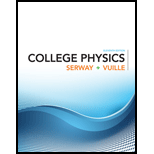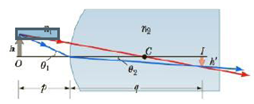
Concept explainers
Figure P23.28 shows a curved surface separating a material with index of refraction n1 from a material with index n2. The surface forms an image I of object O. The ray shown in red passes through the surface along a radial line. Its angles of incidence and refraction are both zero, so its direction does not change at the surface. For the ray shown in blue, the direction changes according to n1 sin θ1 = n2 sin θ2. For paraxial rays, we assume θ1 and θ2 are small, so we may write n1 tan θ1 – n2 tan θ2. The magnification is defined as M = h′/h. Prove that the magnification is given by M = –n1q/n2p.

Figure P23.28
Trending nowThis is a popular solution!

Chapter 23 Solutions
Bundle: College Physics, Loose-Leaf Version, 11th + WebAssign Printed Access Card for Serway/Vuille's College Physics, 11th Edition, Multi-Term
- 1. At 0°C a steel cable is 1km long and 1cm diameter when it is heated it expands and its resistivity increases. Calculate the change in resistance of the cable as it is heated from 0-20°C The temperature coefficient of resistance a, gives the fractional increase in resistance per °C. So increase in resistance AR = Ra.AT Where R, is the resistance at 0°C For steel a, 0.003 °C The coefficient of linear expansion a- gives the fractional increase in length per °C temperature rise. So increase in Length AL La-AT Where L, is the length at 0°C For steel a₁ = 12 x 10 °C-1 The resistivity of steel at 0°C = 1.2 x 10 Qmarrow_forward1. F E 6V 10 1.1. B a 6V b C C Apply Kirchoff's 1st law to point C for the circuit above Apply Kirchoff's 2nd Law to loops: a. ABCFA b. ABDEA C. FCDEF d. Find values for currents a,b and c Darrow_forward2. The results of the Rutherford experiment can be categorized in 3 statements. Fill in the missing words Most 11. Some III. A few State which result gives evidence that the nucleus is a. heavier than an alpha particle b. very small compared to the size of the atom c. positively charged 3. Using values in the diagram derive an expression for r .0 e marrow_forward
- 3. A 100 W light bulb is connected to 230 V mains supply by a cable with resistance 0.12. Determine the heat loss per second by the cable.arrow_forward1. The image shows electrons flowing in a conductor with cross sectional area 1mm². A electron flow • Add an arrow showing the direction of current. B • Which end has the highest potential? • Calculate the current when 1019 electrons flow through the wire in 10 s. If there are 1026 electrons per unit volume what is the drift velocity of the electrons?arrow_forwardpls helparrow_forward
- No chatgpt pls will upvote Already got wrong chatgpt answerarrow_forwardPART III - RESISTORS IN PARALLEL Consider (but do not yet build) the circuit shown in the circuit diagram to the left, which we will call Circuit 3. Make sure you are using Bert bulbs. You may want to wire two batteries in series rather than use a single battery. 7. Predict: a) How will the brightness of bulb B3A compare to the brightness to bulb B3B? c) X E B3A b) How will the brightness of bulb BзA compare to the brightness of bulb B₁ from Circuit 1? How will the currents at points X, Y, and Z be related? www d) How will the current at point X in this circuit compare to the current at point X from Circuit 1? Y Z B3B wwwarrow_forwardPART II - RESISTORS IN SERIES Consider (but do not yet build) the circuit shown in the circuit diagram to the left, which we will call Circuit 2. Make sure you are using Bert bulbs. You may want to wire two batteries in series rather than use a single battery. 4. Predict: a) How will the brightness of bulb B₂ compare to the brighness to bulb B2B? X B2A E Y B2B Ꮓ b) How will the brightness of bulb B2A compare to the brightness of bulb B₁ from Circuit 1? c) How will the currents at points X, Y, and Z be related? d) How will the current at point X in this circuit compare to the current at point X from Circuit 1?arrow_forward
 Physics for Scientists and Engineers: Foundations...PhysicsISBN:9781133939146Author:Katz, Debora M.Publisher:Cengage Learning
Physics for Scientists and Engineers: Foundations...PhysicsISBN:9781133939146Author:Katz, Debora M.Publisher:Cengage Learning Principles of Physics: A Calculus-Based TextPhysicsISBN:9781133104261Author:Raymond A. Serway, John W. JewettPublisher:Cengage Learning
Principles of Physics: A Calculus-Based TextPhysicsISBN:9781133104261Author:Raymond A. Serway, John W. JewettPublisher:Cengage Learning Physics for Scientists and EngineersPhysicsISBN:9781337553278Author:Raymond A. Serway, John W. JewettPublisher:Cengage Learning
Physics for Scientists and EngineersPhysicsISBN:9781337553278Author:Raymond A. Serway, John W. JewettPublisher:Cengage Learning Physics for Scientists and Engineers with Modern ...PhysicsISBN:9781337553292Author:Raymond A. Serway, John W. JewettPublisher:Cengage Learning
Physics for Scientists and Engineers with Modern ...PhysicsISBN:9781337553292Author:Raymond A. Serway, John W. JewettPublisher:Cengage Learning University Physics Volume 3PhysicsISBN:9781938168185Author:William Moebs, Jeff SannyPublisher:OpenStax
University Physics Volume 3PhysicsISBN:9781938168185Author:William Moebs, Jeff SannyPublisher:OpenStax College PhysicsPhysicsISBN:9781305952300Author:Raymond A. Serway, Chris VuillePublisher:Cengage Learning
College PhysicsPhysicsISBN:9781305952300Author:Raymond A. Serway, Chris VuillePublisher:Cengage Learning





